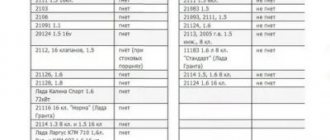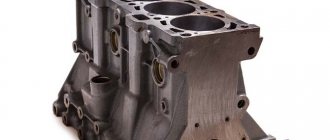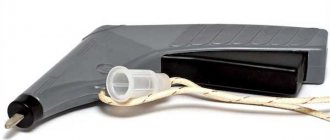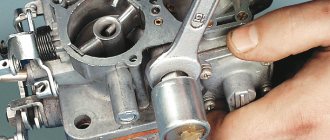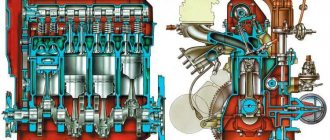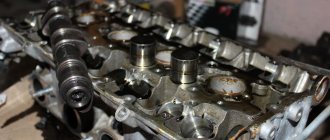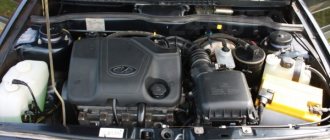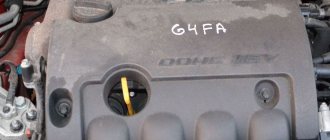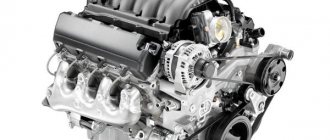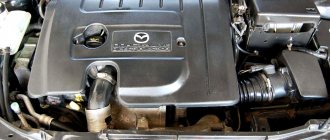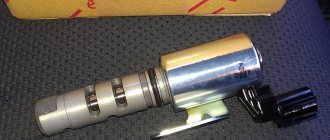Engine Lada Granta 8 valve 1.6 liter capacity is currently the most popular among budget sedan buyers. The design of the motor is well known not only in the official service center, but also in any garage. Therefore, repair and maintenance of this motor does not cause difficulties and is relatively inexpensive. Today we’ll talk about this engine in more detail.
Gasoline power unit Lada Granta VAZ-11186 with a power of 87 hp. with a displacement of 1.6 liters, it replaced the VAZ-11183 injection engine developing 82 horsepower. The new lightweight piston group from Federal Mogul managed to increase the power and efficiency of the power unit. Of course, the engine is not distinguished by enchanting dynamics and low fuel consumption, but its relatively simple design and maintainability allow us to talk about a good option for our harsh operating conditions.
As for the technical part, it is based on a cast-iron cylinder block, an aluminum head, an aluminum cylinder head cover, and a steel engine sump. The timing drive of the Lada Granta is 8-cl. there is a belt. The eight-valve timing mechanism does not have hydraulic compensators; valve adjustment occurs rarely, but the process is quite painstaking. It is necessary to select “nickels” of different thicknesses and place them between the camshaft cams and the bottoms of the pusher cups. The first time such a procedure is carried out is at the so-called “0” zero maintenance, after 3000 km.
The age-old question : Do the valves on the Grant VAZ-11186 engine bend when the timing belt breaks? The answer is clear: when the valve belt breaks, it bends! The engine is paired with a 5-speed manual transmission; no other options are provided.
Further technical characteristics of the base Lada Granta engine 8 valves 87 hp.
Engine Lada Granta 1.6 (87 hp), fuel consumption, dynamics
- Working volume – 1597 cm3
- Number of cylinders/valves – 4/8
- Timing drive - belt
- Cylinder diameter – 82 mm
- Piston stroke – 75.6 mm
- Power hp/kW – 87/64 at 5100 rpm
- Torque – 140 Nm at 3800 rpm
- Maximum speed – 167 kilometers per hour
- Acceleration to the first hundred – 12.2 seconds
- Fuel consumption in the city – 9.0 liters
- Fuel consumption in the combined cycle – 6.6 liters
- Fuel consumption on the highway - 5.8 liters
AI-95 gasoline as fuel .
Lada Granta 8 valve engine, characteristics, dynamics, fuel consumption
The Lada Granta 8 valve engine with a volume of 1.6 liters is currently the most popular among buyers of a budget sedan. The design of the motor is well known not only in the official service center, but also in any garage. Therefore, repair and maintenance of this motor does not cause difficulties and is relatively inexpensive. Today we’ll talk about this engine in more detail.
Gasoline power unit Lada Granta VAZ-11186 with a power of 87 hp. with a displacement of 1.6 liters, it replaced the VAZ-11183 injection engine developing 82 horsepower. The new lightweight piston group from Federal Mogul managed to increase the power and efficiency of the power unit. Of course, the engine is not distinguished by enchanting dynamics and low fuel consumption, but its relatively simple design and maintainability allow us to talk about a good option for our harsh operating conditions.
As for the technical part, it is based on a cast-iron cylinder block, an aluminum head, an aluminum cylinder head cover, and a steel engine sump. The timing drive of the Lada Granta is 8-cl. there is a belt. The eight-valve timing mechanism does not have hydraulic compensators; valve adjustment occurs rarely, but the process is quite painstaking. It is necessary to select “nickels” of different thicknesses and place them between the camshaft cams and the bottoms of the pusher cups. The first time such a procedure is carried out is at the so-called “0” zero maintenance, after 3000 km.
The age-old question : Do the valves on the Grant VAZ-11186 engine bend when the timing belt breaks? The answer is clear: when the valve belt breaks, it bends! The engine is paired with a 5-speed manual transmission; no other options are provided.
Further technical characteristics of the base Lada Granta engine 8 valves 87 hp.
Engine Lada Granta 1.6 (87 hp), fuel consumption, dynamics
- Working volume – 1597 cm3
- Number of cylinders/valves – 4/8
- Timing drive - belt
- Cylinder diameter – 82 mm
- Piston stroke – 75.6 mm
- Power hp/kW – 87/64 at 5100 rpm
- Torque – 140 Nm at 3800 rpm
- Maximum speed – 167 kilometers per hour
- Acceleration to the first hundred – 12.2 seconds
- Fuel consumption in the city – 9.0 liters
- Fuel consumption in the combined cycle – 6.6 liters
- Fuel consumption on the highway - 5.8 liters
AI-95 gasoline as fuel .
Engine VAZ 11186 1.6 l
Experts consider the VAZ 11186 engine as a modernization of the 21114 engine, a secondary modification of the 21083, or an improvement in the characteristics of the 11183 internal combustion engine.
The first option is considered more correct, since the design of 11186 and 21114 is absolutely identical, with the exception of the pistons.
The 11186 engine is equipped with AvtoVAZ products, and the previous version of the internal combustion engine was equipped with pistons from the manufacturer Federal Mogul (USA), which developed it under a contract with the Volzhsky Automobile Plant.
ICE 11186 compared to 11183
Characteristics of motor 11186
The project of a “people's car” at a budget price for the average LowCost user was seriously hampered by the economic crisis. For the Lada Granta Standard configuration, the technical characteristics of the existing ICE 11183 were sufficient.
However, for the Norma and Lux trim levels, a more powerful internal combustion engine was needed, so the management of AvtoVAZ, not having sufficient funding for the project of a new engine, came out of the situation as follows:
- the existing version 21114 became the basis for the ICE 11186;
- to reduce costs, pistons from the American manufacturer Federal Mogul were replaced with domestic products of a suitable size;
- The manufacturer changed the engine markings, but no more design changes were made.
Piston 11186 is smaller than 11183
Unlike 11183, the piston of the 11186 motor bends the valve when the timing belt breaks, but the performance characteristics are improved:
| Manufacturer | AvtoVAZ |
| Engine brand | 11186 |
| Years of production | 2011 – … |
| Volume | 1598 cm3 (1.6 l) |
| Power | 64.2 kW (87 hp) |
| Torque moment | 140 Nm (at 3800 rpm) |
| Weight | 140 kg |
| Compression ratio | 10,5 |
| Nutrition | injector |
| Motor type | in-line |
| Injection | electronic multipoint |
| Ignition | the electronic unit |
| Number of cylinders | 4 |
| Location of the first cylinder | TVE |
| Number of valves on each cylinder | 4 |
| Cylinder head material | aluminum alloy |
| Intake manifold | plastic receiver, electronic throttle |
| An exhaust manifold | combined with catalyst |
| Camshaft | from 11183 |
| Cylinder block material | cast iron |
| Cylinder diameter | 82 |
| Pistons | lightweight |
| Crankshaft | ductile iron, oil channels |
| Number of main bearings | 5 |
| Piston stroke | 75.6 mm |
| Fuel | AI-95 |
| Environmental standards | Euro 4 |
| Fuel consumption | highway – 5.7 l/100 km mixed cycle 7.3 l/100 km city – 8.5 l/100 km |
| Oil consumption | maximum 1 l/1000 km |
| Engine oil for 11186 | 5W-30 and 10W-30 |
| Engine oil volume | 3.5 l |
| Operating temperature | 95° |
| Motor life | declared 150,000 km actual 300,000 km |
| Adjustment of valves | washers between camshaft cams and tappets |
| Cooling system | forced, antifreeze/antifreeze |
| Coolant quantity | 7.8 l |
| water pump | polymer impeller |
| Candles for 11186 | BPR6ES, A17DVRM |
| Gap between spark plug electrodes | 1.1 mm |
| Timing belt | 163 teeth, pitch 8 mm, belt width 26.7 mm |
| Cylinder operating order | 1-3-4-2 |
| Air filter | Nitto, Knecht, Fram, WIX, Hengst |
| Oil filter | catalog number 90915-10001 replacement 90915-10003, with check valve |
| Flywheel | from 2110, steel crown placed on a cast iron body |
| Flywheel mounting bolts | MT box – M10x1.25 mm, length 26 mm, groove 11 mm AT box – M10x1.25 mm, length 26 mm without groove |
| Valve stem seals | code 90913-02090 inlet light code 90913-02088 exhaust dark |
| Compression | 13 bar |
| XX speed | 650 – 750 min-1 |
| Tightening force of threaded connections | spark plug - 18 Nm flywheel - 62 - 87 Nm clutch bolt - 19 Nm bearing cap - 68 Nm (main) and 53 (connecting rod) cylinder head - three stages 29 Nm, 49 Nm and 90° |
Since the engine does not have hydraulic valve lash compensators, it is practically not important for the user which oil to choose based on the fuel manufacturer. Both domestic and foreign companies are suitable, for example, ZIK, Lukoil, Mobil, Rosneft. On the other hand, relevant information is which oil to pour into the engine based on viscosity:
- for regions of the Russian Federation, the manufacturer recommends all-season oils 10W40, 5W40 and 15W30;
- Synthetic and semi-synthetic lubricants are allowed;
- It is better not to use mineral oil.
To reduce temperature loads on the valves, the engine circuit provides nozzles that inject oil onto their surface. Unlike homemade channels, nozzles fire only when pressure increases, that is, when the lubricant heats up from intense loads. Oil does not enter the crankcase and does not cause increased wear of gaskets in the engine.
Timing diagram Lada Granta 8 valves
- 1 - crankshaft toothed pulley
- 2 - coolant pump toothed pulley
- 3 - tension roller
- 4 - rear protective cover
- 5 - camshaft gear pulley
- 6 - timing belt
- A - boss on the rear protective cover
- B - mark on the camshaft pulley
- C - mark on the oil pump cover
- D - mark on the crankshaft pulley.
Another feature of the engine is the location of the water pump (pump), which is rotated by the same timing belt. That is, in case of coolant leaks or characteristic noise/whistle/hum in the timing drive area, checking the belt is mandatory. If the pump bearing crumbles and the belt comes off, then in addition to replacing the water pump housing and belt, you will also have to go through the cylinder head, removing bent valves from there.
AvtoVAZ uses a very reliable Gates belt as the original belt. Often the service life of the Gates belt is much higher than the service life of the pump and tension pulley of the Lada Granta 8-valve engine.
The most common problems of internal combustion engines 11186
Malfunctions of the VAZ 11186 begin after 60,000 kilometers, if you do not visit the service center at 40 thousand. Knocks may appear in the VAZ engine. They indicate unadjusted valve clearances. If everything is fine with them, then pay attention to the connecting rod and main bearings of the crankshaft. They may need to be replaced.
If the speed in the VAZ engine fluctuates. The problem may lie in a malfunction of the throttle valve. It is necessary to check the functionality of the damper sensors. If they are not working properly, replace them with new ones.
If the thermostat breaks down, the VAZ 11186 engine begins to warm up slowly. When starting, it stalls - problems with the mass air flow sensor. If the mass air flow sensor is not repaired in time, the car may stall while driving somewhere on the highway.
There may be problems with the ignition unit or the standard electronic unit. The latter is unreliable. Therefore, if glitches appear in the control unit, it is better to replace it immediately.
Similar article Where is the engine number on the Lada Granta
Among the critical breakdowns, experienced mechanics identify problems with the pump and tension roller. If the roller jams, the teeth of the timing belt are cut off. The valve bends in almost every such case. The engine is immediately sent for overhaul. Therefore, it is better to avoid roller wedge and problems with the pump.
Lada Granta engines 8 valves
This power unit was installed only until December 2014, until it gave way to the 11186 internal combustion engine. This is an injection 8-valve engine with a single camshaft, a timing belt drive and without hydraulic compensators, so the thermal valve clearances here will have to be adjusted yourself. Thanks to special holes in the pistons, if the valve belt breaks, it will never bend.
There are plenty of problems with this engine; first of all, owners are bothered by all sorts of noises, knocks, and vibrations. Unreliable electrics, as well as a capricious thermostat, can throw you many unpleasant surprises. Due to poor fuel, valve burnout sometimes occurs here.
Sedan before restyling 2011 - 2019
| 1.6 l 11183 MKP5 | |
| Type | injector |
| Fuel | gasoline AI-92 |
| Location | transverse |
| Cylinders | 4 in a row |
| valves | 8 |
| Working volume | 1596 cm³ |
| Power | 82 hp |
| Torque | 132 Nm |
| Acceleration to 100 km/h | 12.6 s |
| Speed (max) | 165 km/h |
| Ecological Class | Euro 4 |
| Consumption city | 9.7 l |
| Flow track | 6.1 l |
| Mixed flow | 7.4 l |
Similarly, the Motor VAZ website talks about all the details of the internal combustion engine design
This unit is an improved version of the previous one. There is already a lightweight piston with anti-friction inserts, a timing belt from Gates with a service life of 180 thousand km, an electronic throttle valve, a developed cooling jacket and many other improvements, thanks to which it was possible to fit this rather old engine into the strict EURO 4 econorms. Due to the new pistons without holes in the bottom, if the valve belt breaks, it almost always bends. Update: in mid-2021, the manufacturer equipped the unit with plugless pistons.
The list of typical malfunctions of this power unit is quite long. Owners of cars with such an engine regularly encounter burnout of valves due to bad gasoline, overheating, oil leaks, failures of various sensors, and also glitches of the E-gas system.
Sedan before restyling 2011 - 2019
| 1.6 l 11186 manual gearbox5 | 1.6 l 11186 automatic transmission4 | |
| Type | injector | injector |
| Fuel | gasoline AI-92 | gasoline AI-92 |
| Location | transverse | transverse |
| Cylinders | 4 in a row | 4 in a row |
| valves | 8 | 8 |
| Working volume | 1596 cm³ | 1596 cm³ |
| Power | 87 hp | 87 hp |
| Torque | 140 Nm | 140 Nm |
| Acceleration to 100 km/h | 12.2 s | 14.2 s |
| Speed (max) | 167 km/h | 160 km/h |
| Ecological Class | Euro 4 | Euro 4 |
| Consumption city | 9.0 l | 10.4 l |
| Flow track | 5.8 l | 6.1 l |
| Mixed flow | 6.6 l | 7.7 l |
The technical features of the engine are described in an article in Za Rulem magazine
Design Features
The main feature of this engine was the replacement of the piston part from an American manufacturer with pistons from a Russian company. The VAZ engine markings have also changed.
Engine 11186 adopted the design base from engine 21114. When the belt breaks, the piston of the VAZ engine of this model bends the valve. This must be taken into account and carefully monitor the appearance of cracks on the belt. However, they began to make this spare part of the motor durable, so there is a possibility that the belt will survive with the motor until a major overhaul.
I provided a description of the full technical characteristics above. Now I will talk about the oils that need to be poured into the engine so that it does not seize.
- all-season vehicles for all regions of the Russian Federation. Namely 10W40, 5W40, 15W30;
- Mineral based oil is not recommended. Semi-synthetic is allowed, but it is better to use a synthetic lubricant;
- Oils from the following companies are suitable for filling: Lukoil, Rosneft, Mobil, Zic.
To reduce overheating of the VAZ engine, nozzles were used that inject oil onto the surface of the valves. This prevents lubricant from entering the crankcase and causing gasket wear.
The piston skirt, compared to the skirt on other engines, was made lighter by being reduced in size. The engine size was increased, but not by much. A modern E-gas throttle valve is installed.
Similar article Technical characteristics of the VAZ 2130 engine
All these innovations made it possible to increase the power of the VAZ engine, increase its reliability and raise the engine’s environmental class to Euro 4. To prevent the belt from breaking the valve if it breaks, an expensive spare part from Gates is installed. Therefore, we can easily say that the timing belt chain will serve the car owner for a long time.
In the city, a car with this engine consumes 9 liters per 100 kilometers. When driving on the highway, gasoline consumption will decrease by 4 liters and become 5.3 liters per 100 km. If the VAZ engine operates in mixed mode, then the burn rate does not exceed 6.8 liters per 100 kilometers.
Some experienced car owners complain about the noisy operation of the VAZ engine. When noise first appears, you should contact a service center. And once a year, experienced mechanics advise coming for preventive maintenance.
Lada Granta engines 16 valves
This engine is also equipped with a lightweight piston group manufactured by Federal Mogul and a belt with an automatic tensioner from Gates. It is distinguished by a 16-valve head with a pair of camshafts and hydraulic compensators, due to which its power is significantly higher.
All the problems of its predecessors apply to this unit in full. The engine often suffers from lubricant leaks, tripping, floating speed, sensor glitches and valve burnout. Plus, you can add hydraulic compensators that are very demanding on oil quality.
Hatchback before restyling 2015 - 2019
| 1.6 l 21126 MKP5 | 1.6 l 21126 automatic transmission4 | |
| Type | injector | injector |
| Fuel | gasoline AI-92 | gasoline AI-92 |
| Location | transverse | transverse |
| Cylinders | 4 in a row | 4 in a row |
| valves | 16 | 16 |
| Working volume | 1596 cm³ | 1596 cm³ |
| Power | 98 hp | 98 hp |
| Torque | 145 Nm | 145 Nm |
| Acceleration to 100 km/h | 11.2 s | 13.3 s |
| Speed (max) | 182 km/h | 173 km/h |
| Ecological Class | Euro 5 | Euro 5 |
| Consumption city | 8.8 l | 9.9 l |
| Flow track | 5.6 l | 6.1 l |
| Mixed flow | 6.8 l | 7.2 l |
All technical characteristics of the engine are described on the Motor VAZ portal
The updated engine received an adjustable intake tract with dampers in the receiver channels. Also here, the mass air flow sensor gave way to a combination of absolute pressure and air temperature sensors, thanks to which the frequent problem of floating speed at idle has finally gone away.
The reliability of the new unit has increased, although it is not flawless. The thermostat also often fails, the injectors become clogged, and the ignition system malfunctions. But the main threat is the water pump, because of the wedge of which the timing belt breaks and the pistons meet the valves. Update: In July 2021, the manufacturer equipped this engine with plugless pistons.
Hatchback before restyling 2015 - 2019
| 1.6 l 21127 MKP5 | 1.6 l 21127 AMT5 | |
| Type | injector | injector |
| Fuel | gasoline AI-92 | gasoline AI-92 |
| Location | transverse | transverse |
| Cylinders | 4 in a row | 4 in a row |
| valves | 16 | 16 |
| Working volume | 1596 cm³ | 1596 cm³ |
| Power | 106 hp | 106 hp |
| Torque | 148 Nm | 148 Nm |
| Acceleration to 100 km/h | 10.9 s | 12.3 s |
| Speed (max) | 183 km/h | 180 km/h |
| Ecological Class | Euro 5 | Euro 5 |
| Consumption city | 8.6 l | 9.0 l |
| Flow track | 5.6 l | 5.2 l |
| Mixed flow | 6.5 l | 6.5 l |
All differences from its predecessors are described in one of the blogs on Drive 2
Engine on Grant: features
So, the Grant 21116 1.6-liter 8-valve gasoline engine is a modernized 1.6-liter VAZ 2114 engine. The idea to modernize the VAZ 2114 engine arose in connection with the release of the Grant car and the transition of the entire model range to Euro-4.
Initially, ICE 21116 was installed on the Lada Priora and then on the Lada Granta and Lada Kalina cars. List of main technical characteristics:
- injection power system;
- in-line 4-cylinder engine with a power of 87 hp;
- engine capacity 1596 cm3;
- the presence of two valves per cylinder;
- the maximum torque is 140 Nm;
- the presence of an intake manifold with extended channels and a flange for an electronic damper (increased torque);
- new H-module.
The 87 hp Grant engine, especially in comparison with its predecessor VAZ 21114, has a lightweight connecting rod and piston group. This feature of the 21116 engine has its advantages and disadvantages.
By lightening the parts and elements of the internal combustion engine, the service life of the valve-piston group decreases, but at the same time the dynamics and other indicators improve. For example, an increase in power to 87 hp, which is 6 hp. more than that of ICE 21114.
Main characteristics of the Lada Grand car with a VAZ 21116 engine installed on it:
- The maximum speed of the car is 167 km/h;
- Fuel consumption 8.5 l. per 100 km (when driving in the urban cycle);
- Fuel consumption 5.7 l. per 100 km (when driving on the highway);
Let's move on. If we consider the Granta 8-valve engine and its design, the Granta 8-valve engine has several design features that distinguish it from other modifications.
Firstly, the plate honing method is used to finalize the surfaces of the cylinders. Secondly, the presence of oil nozzles allows for more intensive lubrication and cooling of the pistons.
The dimensions of the internal combustion engine parts have also been reduced: the height of the cylinder block is about 197.1 mm; the crank radius is about 37.8 mm; piston ring height 1.2/1.5/2 mm, etc.
Another thing worth noting is the electromechanical throttle module installed at the receiver input. This design solution allows the ECU to fully control both the fuel supply and the air supply to the cylinders.
Let us add that the main design feature of the Grant 21116 internal combustion engine was the lightweight ShPG connecting rod and piston group. In the previous model, exhaust gas flows collided and created back pressure.
For this reason, in the case of the VAZ 21116, the designers decided to lengthen the collector pipes by changing the shape of the cylindrical block and the inlet pattern. As a result, such actions helped reduce losses and resistance.
Engine characteristics Grants
The VAZ 11183 engine was first used for installation on the Lada Kalina. This is a four-cylinder device with 8 valves and a volume of 1.6 liters. Structurally, this power unit is almost no different from the 21114 engine, widely used by the manufacturer on its models, starting with the VAZ-2109 and ending with modifications of the Kalina.
According to experts, both 11183 and 21114 have the same parameters and characteristics of all parts of the engine: block, camshaft, head, valves, crank mechanism, etc. That is, in fact, these are the same engine with different names .
11183 is characterized by increased environmental friendliness, reliability and increased volume. The timing drive is a belt drive, located in such a way that a broken belt does not bend the valves. This is also facilitated by deep piston recesses.
According to the plant, the service life of 21114 does not exceed 150 thousand km, but in practice the engine has successfully covered a mileage of 200 thousand. The service life of 11183 officially has an indicator of 200 thousand km.
Engine 11186 is a thoroughly modernized version of 11183 and is completely similar to engine 21116, created specifically for the Lada Granta. The differences between 11186 and 21116 lie in the manufacturer of the piston system: the first uses designs from the Federal Mogul plant, the second from AvtoVAZ. 11186 is considered the main engine of the Lada Granta liftback modification.
The modernization of the engine was carried out by engineers from the Volzhsky enterprise. They managed to achieve a reduction in the specific consumption of fuels and lubricants, while the minimum engine resource increased to 200 thousand km.
The new Lada Granta liftback car is equipped with 3 types of engines: 11186, 21126 and 21127. The VAZ 21126 with 16 valves and 2 camshafts is considered the main engine of the car. The technical characteristics of such an engine allow it to develop power up to 98 hp. and be combined with an automatic transmission. But in comparison with 21116, the 21126 engine has higher gasoline consumption and worse dynamic performance.
An even more advanced power unit 21127 allows you to achieve a power of 108 hp. At the same time, fuel consumption per 100 km range is reduced by almost 1 liter. The technical characteristics were improved by introducing into the mechanism of the intake manifold of the engine a part that performs passive supercharging.
The greatest interest among fans of AvtoVAZ models is the Lada Granta liftback, equipped with the 21127 engine, since it combines high power with the possibility of installation on an automatic transmission.
Lada Granta 8 valve: main faults
Even taking into account the fact that the internal combustion engine of the Lada Granta 21116 is not the most complex unit structurally, certain problems associated with certain engine malfunctions may still arise during operation.
Main malfunctions and methods for their elimination:
- The occurrence of knocks and noises. The problem is misaligned valve clearances or defects in the pistons, connecting rods or crankshaft main bearings. The problem is eliminated by adjusting the gaps by repairing or replacing damaged parts;
- The occurrence of floating idle speed. The problem is related to a failure in the electronic throttle control system “E-gas”, namely the failure of its sensors. The malfunction is determined by testing the system and replacing the sensors;
The internal combustion engine begins to malfunction (dips occur, loss of power). Most often, this problem is associated with burnout of one of the valves or failure of the ignition coil. The problem is solved by restoring old parts or replacing them with new ones.
- Normal warming up of the engine is disrupted or rapid overheating occurs (the engine “boils”). The problem is related to a broken thermostat. In this case, the thermostat is replaced;
- The car stalls while driving. This problem may be due to a malfunction of the mass air flow sensor;
- The appearance of oil leaks in the area of the oil cap and valve cover, etc. Oil can leak for various reasons: wear of the valve cover gasket, the appearance of defects on the valve cover itself, failure of the piston group, etc.
- It can also be noted that a collision of pistons with valves can cause serious damage. This happens when the pump bearing jams, the timing belt breaks, etc. As a result, expensive engine repairs will be required.
Why Granta 8-valve valve bending
The valves do not bend on all Grants. In the “Standard” modification, another unit is installed - 11183 or a transitional version 11183-50. It is less powerful, noisier and more gluttonous, but it does not bend the valves. But “Norma” and “Lux” are equipped with 11186, which requires special attention.
To achieve the best technical performance, AvtoVAZ engineers lightened the connecting rod and piston group (CPG) of the engine by 39%. But the updated ShPG did not include counterbores in the piston heads. The “oversight” led to the fact that if the timing belt on the 11186 engine is damaged, the valves bend in 99% of cases. Here's how it happens:
- The timing drive has broken.
- The camshaft has stopped.
- The valves remained open.
- The crankshaft rotates by inertia from the flywheel.
- The pistons push back and hit the valves.
- The impact bends the valve stems.
VAZ tried to fix the problem that caused the valve stems to bend. Federal Motors, the SHPG supplier, learned to produce pistons with recesses on the bottom, which finally helped get rid of the critical flaw. Grants with a non-plug motor went on sale from August 15, 2021.
The modified design of the pistons includes recesses for the full stroke of the valves, so the possibility of collision of parts, which causes valve bending, is excluded. In addition, the piston skirts have become more wear-resistant due to a new coating and geometry. The modifications helped reduce noise and improve gas economy.
Lada Granta 21116 engine life, maintenance, pros and cons
The Lada Granta 21116 engine model under consideration differs from its predecessors in sufficient reliability and efficiency. If you take into account compliance with the operating and maintenance conditions (time frames for maintenance), you can significantly extend the service life of the unit.
Features of servicing the VAZ 21116 engine:
If you study the reviews of VAZ 21116 owners, then the internal combustion engine of the Lada Granta 21116 with an engine capacity of 1.6 and a power of 87 horsepower pulls well at the bottom, as well as when driving at full power.
Fuel consumption per 100 km, even when driving in city traffic (traffic jams, traffic lights), usually does not exceed 10 liters. By the way, the use of AI-95 fuel recommended by the manufacturer can reduce fuel consumption even further.
We also recommend reading the article about how to do tuning the Lada Vesta engine. From this article you will learn about the available methods for tuning the Lada Vesta engine, how to increase power and boost the specified internal combustion engine.
You can also note the normal start of the engine in cold weather, even after the car has been idle for a long time. Also a plus is a reduction in noise (minimal vibration) and an increase in the torque of the internal combustion engine.
The only drawback is a broken engine timing belt, which leads to bending of the valves (as a result, expensive repairs). Also, in some cases, the fragility of the pistons is noted (when they collide with the valves, they sometimes break and require replacement much earlier than their allotted time);
What's the result?
As you can see, with the modernized 8-valve engine of the Lada Granta, not only fuel consumption has been reduced, but also dynamic performance has increased, since there is a reduction in mechanical losses. Also a plus was the reduction of vibrations and noise, and increased comfort.
We also recommend reading an article about what features, as well as advantages and disadvantages, of the Lada X-Ray engine. From this article you will learn what engine is installed on the Lada X-Ray, as well as what pros and cons this power unit has.
Finally, we note that even taking into account the lighter weight of the CPG parts, with proper and regular maintenance, we can talk about increasing the reliability of the unit, since improvements have increased its service life to 200 thousand kilometers. As practice shows, this is a very good indicator for VAZ engines.
Dynamics
External view of engine 21116
This is not a racing car, but there is enough power for both city driving and highway driving. If we compare it with the 16-valve engine of the Lada Granta, which is installed on the Luxury versions, then it has more torque at the bottom. This means that you can drive in 5th gear at a speed of 40 km/h.
For example, you are driving at 5 speed, the traffic light in front lights up red. You release the gas pedal and the car brakes with the engine. The light turns green and you can continue driving in 5th gear even if the vehicle speed has dropped to 40 km/h.
I was pleasantly surprised by the elasticity of the motor. Considering that I previously owned a Priora, and it has a 98 hp engine, then the engine is 87 hp. I like grants better.
Engine Features
Due to the design of the car's cooling system, the engine does not warm up above 80 degrees. The management of AvtoVAZ does not see anything wrong with this; they have an official information letter on this matter. You can read it in the material: What is the operating temperature of an 8 valve engine.
The engine design is as simple as an axe. There are no hydraulic compensators, no sores were noticed. Mostly problems can arise due to malfunctions in the engine management system.
Video of acceleration to 100 km per hour
I haven’t shot my video yet, it’s winter, so we’ll wait for the weather to warm up. That's when I'll post it on our YouTube channel. In the meantime, here's a video from Grantovodov.
Here's another interesting video. It is interesting because the measurement is made using an application with a navigator , which means that the speedometer readings are more accurate if the navigator is well calibrated. Everyone knows that the higher the speed, the more the car’s speedometer lies.
Noise level
I switched to this car from the Renault Megane 2. My Renault was equipped with a 1.6-liter engine, a power of 113 horses, and the number of valves was 16.
After it, the Granta engine works like a tractor. Regardless of the car's mileage. Even the engine on the carburetor VAZ-21093 seemed quieter to me.
I specifically compared the noise level on a new Grant with a mileage of 5,000 km and on mine with a mileage of 55,000 km. As it warms up, the sound becomes quieter, but most likely you just get used to it.
But it is also worth considering that there are no hydraulic compensators, so you will have to adjust the valves. By the way, the engine in the luxury version (98 hp) also rumbles.
Engine life
Under the hood in the “Norma” configuration
The question that causes the most controversy. Officials talk about a mileage of 150,000 km before major repairs; some have traveled 200 thousand km or more without problems. I have a friend who already had his engine repaired at 40 thousand km because the timing belt broke. Yes, the engine here is “plug-in” - this means that if the timing belt breaks, the pistons meet the valves and you can see the fist of friendship.
Engine resource 87 hp. 21116 according to the passport - 150,000 km!
Studying the forums, based on my own experience, I can say that it all depends on how you will operate the engine. The most banal thing: the quality of the oil (choose correctly) and engine operating modes - this is what the mileage before you need to do major repairs depends on.
Specifications
Technical characteristics of VAZ 11182 (Largus 5MT)
:
- Cylinder displacement - 1596 cm3
- Maximum power - 66 kW (90 hp) / 5000 rpm. min.
- Maximum torque - 143N∙m (3800min-1)
- Torque at 1000 rpm - 112N∙m
- Number of cylinders - 4
- Valves per cylinder - 2
- Compression ratio - 10.5
- Maximum speed - 160km/h
- Acceleration time 0-100 km/h - 14.0 s
- Fuel consumption in the combined cycle - 7.5 l/100 km
- Specific fuel consumption - 390 g/kWh
- Fuel - gasoline with an octane rating of at least 92
- Environmental standard - Euro 5/6
- The resource of the power unit is 200,000 km.
- Structurally, the possibility of contact between the piston and the valve is excluded (in the event of a timing belt break, the valve does not bend).
Reviews from car owners about the 87 hp engine.
Most reviews are positive.
Mostly problems occur due to low-quality fuel and lubricants. The engine may start to stall and run intermittently (floating idle, stalls, loss of power, etc.). In this case, the “Check Engine” malfunction icon (indicator) should light up on the instrument panel.
The engine pulls well at low end; on the highway, even with a full load, there is enough power. This is especially noticeable when compared with a Ford Focus automatic: engine capacity 1.6, power 100 horsepower. Granta drives more fun, Focus “deflates” after 80 km per hour. As for Focus - personal experience, I owned just such a car.
Fuel consumption
Even in a mixed cycle with traffic jams, consumption will not exceed 10 liters per hundred!
Fuel consumption is good. Even in a mixed cycle with traffic jams, consumption will not exceed 10 liters per hundred. My consumption is 8 liters in the city, 6 on the highway. This is on 92 gasoline. I checked from tank to tank, it roughly matches the readings of the on-board computer. On 95 gasoline, which is what AvtoVAZ recommends using, fuel consumption should become even less.
If your consumption exceeds the norm, then you need to look for a malfunction. Do not delay troubleshooting, as your engine may be overloaded.
Starting in the cold
In cold weather it starts, even after a long stay. The main thing is a good battery, a working fuel pump and power system.
What engines are installed on Lada Granta and Kalina 2
The Lada Granta is a budget front-wheel drive car that was developed on the basis of the Lada Kalina. Sales of the car began at the end of December 2011. Currently, 5 types of engines are installed on Lada Granta/Kalina 2:
- VAZ-11183-50 (82 hp)
- VAZ-11186 (87 hp)
- VAZ-21126 (98 hp)
- VAZ-21127 (106 hp)
- VAZ 21126-77 (120 hp)
Despite this diversity, the volume of all engines is the same and is 1.6 liters.
About modern VAZ engines
The manufacturer offers a choice of two 8 valve engines :
- VAZ-11183-50 (82 hp) is a modified VAZ-2111 engine, as a result of which environmental performance has increased, the engine has become more reliable and less capricious. It also has the advantage of elasticity and traction. Disadvantages include periodic valve adjustments and noisy engine operation. If the timing belt breaks, the valve does not bend.
- VAZ-11186 (87 hp) is a modified VAZ-21114 engine, as a result of which it was possible to reduce noise and gasoline consumption. Environmental friendliness has improved and power has increased noticeably. Disadvantages: compared to the VAZ-11183, this engine has a shorter service life. When the timing belt breaks, the valves bend.
16 valve engines :
- VAZ-21126 (98 hp) is a continuation of the VAZ-21124 engine and is currently one of the most advanced domestic engines. Disadvantage: valve bends when the timing belt breaks.
- VAZ-21127 (106 hp) is a modified VAZ-21126 engine. In comparison, the engine has become more torquey at the bottom, the changes are minor, but noticeable. The disadvantages include bending of the valves when the timing belt breaks.
Is it bending on the 8 valve?
In general, to tell the truth, the 16-valve is not oppressive for everyone. The fact is that there are pistons with a groove that follows the contours of the valves. Therefore, the valves go deeper into the groove and no impact occurs. Here's an example:
What about the 8 valve? Here, too, everything is ambiguous and there is no point in drawing hasty conclusions. It all depends on the design of the engine. In my practice, there was a case where the timing chain on a Chevrolet Niva broke and the valves were bent, but on the old nines and tags the valves definitely did not bend. However, even many Grants can boast of such an achievement, but not all.
Starting with the VAZ 11186 engine (87 hp), if the valve belt breaks, bending is guaranteed. In addition, the same thing can happen on motor 21116.
Technical characteristics of VAZ engines
| VAZ-21126-77 | |
| Installed on cars: | Lada Granta Sport and Lada Kalina Sport |
| Years of production, year | since 2013 |
| Cylinder block material | cast iron |
| Supply system | injector |
| Type | in-line |
| Number of cylinders | 4 |
| Valves per cylinder | 4 |
| Compression ratio | 11 |
| Engine volume, l | 1,6 |
| Power | 120hp/5900rpm |
| Torque | 154Nm/4740rpm |
| Fuel consumption (city/highway/mix), l | -/-/7.8 per 100 km |
| Oil consumption | 50g/1000km |
| Engine oil quantity | 3.5l |
| Engine life (according to the passport/actually) | 200/200 thousand km. |
Let us remind you that in another article we determine the best VAZ engine for a modern Lada car.
Technical specifications 11186
Attention! The piston system on the VAZ 11186 engine was created, while the piston system for the predecessor engine was produced by the American.
Engine specifications are in the table below.
| Parameter | Meaning |
| Motor type | Row |
| Number of cylinders | 4 |
| Valves | 8 |
| Volume in cubic cm. | 1596 |
| Cylinder diameter | 82 mm |
| Nutrition | Injection |
| Power | 87 horses |
| Torque | 140 Nm |
| Compression ratio | 10,5 |
| Fuel used | Petrol |
| Fuel type | AI92 |
| Environmental class | Euro 4 |
This engine is considered a modification of the engine of the 80s VAZ 21083 model. It is a cast-iron cylinder block and four cylinders, which are arranged in a row. Equipped with an eight-valve cylinder head and a single-row timing chain.
Does not have hydraulic compensators. The car owner needs to adjust the thermal valve clearances every 40 thousand kilometers. The motor design is SOHC. The engine has one overhead camshaft. And it is driven by a belt.
Attention! The car owner does not need to tension the belt. Since its lifespan coincides with the lifespan of the motor itself.
The lifespan of the motor is 200 thousand kilometers according to the manufacturer. The actual mileage before the first major overhaul has not been calculated by experienced mechanics. Because the manufacturer does not control the mileage of lettered vehicles.
Although, according to reviews from experienced car owners, it became known that the engine can easily withstand the specified 200 thousand kilometers without major repairs.
Similar article Technical characteristics and reviews of the 1GR FE engine
